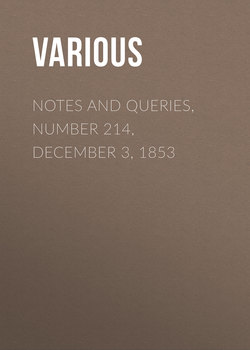Читать книгу Notes and Queries, Number 214, December 3, 1853 - Various - Страница 8
Minor Queries
ОглавлениеHelmets.—What is the antiquity of the practice of placing helmets over the shields of armorial bearings; and what are the varieties of helmets in regard to the rank or degree of persons?
S. N.
The Nursrow.—What is the origin of the word Nursrow, a name applied by Plott, in his History of Staffordshire, to the shrew mouse, and by the common people in Cheshire at the present day to the field-mouse; or rather, perhaps, indiscriminately to field and shrew mice?
N. R.
City Bellmen.—When were city bellmen first established? By whom appointed? What were their duties? What and how were they paid? What have been their employment and duties down to the present day?
Crito.
Pope's Elegy on an Unfortunate Lady.—In the new editions of Pope's Works, in course of publication, edited by Mr. Carruthers, Inverness, it is conjectured that the poet threw "ideal circumstances" into his most pathetic and melodious elegy, and "when he came to publish his letters, put wrong initials, as in other instances, to conceal the real names" (Pope's Poet. Works, Ingram, Cook, and Co., vol. ii. p. 184.). The initials are Mrs. W., niece of Lady A. I have always thought that a clue might be obtained to the name of this lady, by following up the hints in Pope's printed correspondence. Mrs. or Miss W. is mentioned or alluded to by Craggs and Pope, in connexion with the characters in the Rape of the Lock. One suggests the other. Inquiry should be directed to the families of Fernor of Tusmore, Lord Petre, and Sir George Brown. But I have heard a tradition in a Catholic family in the north of England that the lady was a Blount; probably one of the Blounts of Soddington, or of some one of the numerous branches of that ancient family.
An Inquirer.
"Too wise to err, too good to be unkind."—In what author may this passage be found?
"Too wise to err, too good to be unkind."
E. P. H.
Clapham.
Passage in the "Christian Year."—In the beautiful lines on Confirmation in this work, the following verse occurs:
"Steady and pure as stars that beam
In middle heaven, all mist above,
Seen deepest in the frozen stream:—
Such is their high courageous love."
I should be grateful for an explanation of the third line.
A. A. D.
David's Mother.—I used to think it was impossible to ascertain from the Old Testament the name of David's mother. In the Genealogies recorded in the Sacred Scriptures, by J. S. (usually assumed to stand for John Speed, the historian and geographer), the name of the Psalmist's mother is given "Nahash." Can this be made out satisfactorily? Will the text 2 Sam. xvii. 25., as compared with 1 Chron. ii. 15., warrant it?
Y. B. N. J.
Emblems.—Can any of your readers inform me what are the emblematic meanings of the different precious stones, or of any of them? or in what work I shall find them described?
N. D.
"Kaminagadeyathooroosoomokanoogonagira."—In an appeal to the Privy Council from Madras, the above unparalleled long word occurs as the descriptions of an estate. I believe that its extreme length and unpronounceable appearance is without an equal. Can any of your readers acquainted with Indian literature translate it? if so, it would greatly oblige
F. J. G.
"Quid facies," &c.—I have lately met with the following curious play on words in an old MS. book. Can any of your correspondents give any account of it?
"Quid facies, facies Veneris si veneris ante?
Ne pereas, per eas; ne sedeas, sed eas!"
Balliolensis.
Will of Peter the Great.—M. Lamartinière, in a French pamphlet on the Eastern question, gives a document in several articles containing advice with respect to the policy of his successors on the throne of Russia, in which he advises her to make great advances in the direction of Constantinople, India, &c., and advocates the partition of Poland. Upon what authority does this document rest? and who is M. Lamartinière?
R. J. Allen.
H. Neele, Editor of Shakspeare.—In the preface to Lectures on English Poetry, being the Remains of the late Henry Neele (Lond. 1830), mention is made of a new edition of Shakspeare's dramatic works, "under the superintendence of Mr. Neele as editor, for which his enthusiastic reverence for the poet of 'all time' peculiarly fitted him, but which, from the want of patronage, terminated after the publication of a very few numbers." These very few numbers must have appeared about 1824-1827; yet the answer to my repeated inquiries after them in London is always "We cannot hear of them." Can any one give me farther information?—From the Navorscher.
J. M.
MS. by Rubens on Painting.—May I inquire of M. Philarète Chasles whether he ever saw or heard of a manuscript said to be written in Latin by Rubens, and existing in the Bibliothèque Nationale at Paris? One or two fragments have occasionally been quoted: I think one may be found in Sir Joshua Reynolds' Discourses, and the same is used by Burnet in his work on painting; but no authority is given as to the source of the information.2
If such a work can be found, it would confer a great boon upon the profession of the fine arts, if it were brought to light without delay.
Weld Taylor.
Peter Allan.—Will some correspondent of "N. & Q." afford information as to the exact date and place of birth of the celebrated Peter Allan, whose cave at Sunderland is regarded as one of the principal curiosities of the north of England? What is known of his general history; and is any member of his family now living?
2
[This may probably be Rubens's MS. Album, of which an account is given in Vertue's Anecdotes of Painting, vol. ii. pp. 185, 186.—Ed.]
